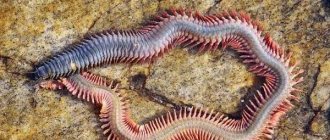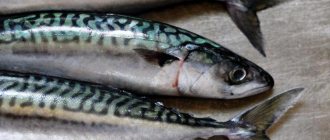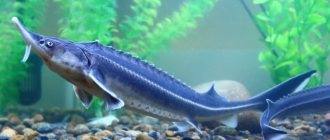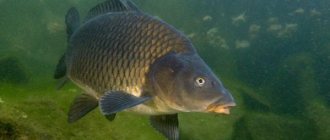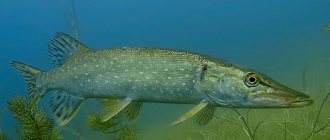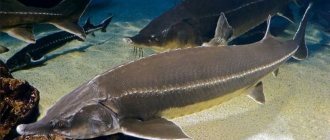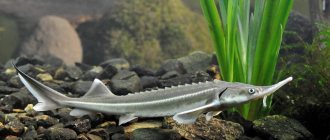Sandstone got its nickname due to its habitat - sea sand.
The closest relative of the earthworm attracts fishermen with its catchability in catching most marine fish.
Has a unique body structure. Its calm behavior and constant hiding in the sand dunes makes its extraction a fascinating process.
How to find sandworm and get it, put it on the hook correctly and increase the effectiveness of this bait - you will learn from this article.
General description of the bait
Inhabitant of sea sand. Grows up to 20 cm in length and 1 cm in diameter. The maximum age of life is 6 years. Multi-colored. The structure of the body is represented by parts. The first part is red-brown in color, the middle part is distinguished by its rich red color and the presence of gill bristles, with the help of which it breathes. The tail part has a brownish tint.
1.1 Sandbiter habitats
Seashore sand, muddy or muddy areas.
1.2 What they eat
Organic matter (detritus) found in sand.
1.3 Where to find the worm
- vegetation (grass) crawls out of the burrow in the evening and in warm weather;
- groups of sandworms crawl out of holes during low tides;
- directly in the hole;
- under stones;
- in the sand of the seabed in a shallow area;
- During the period of egg laying, sandworms swim in the upper layer of water.
Nereis habitat
Nereis live on the seabed, in burrows. They are eaten in large quantities by a variety of commercial fish, Kamchatka crabs and other marine animals.
Nereis are very high in calories. They are the basis of the diet of sturgeon, which is found in the Caspian Sea. They were even specially brought there for this purpose.
Several tens of thousands of Nereis were transported from the Azov Sea to the Caspian Sea in special refrigerators. Moreover, they adapted well to the new conditions and multiplied in large numbers. Today, the mass of these creatures in the Caspian Sea reaches millions of tons. As a result, Caspian sturgeons almost completely switched to feeding on Nereis.
2.Methods of extracting sandstone
The worm's refuge is a burrow, which is presented in the form of a tubercle with rings. Sandstone is not so easy to get. If you grab it by the tail and try to pull it out of the hole, the tail will come off. The tail part of the worm is restored.
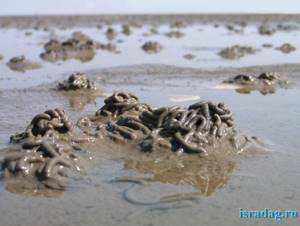
Extraction methods:
- If a sandworm is in a hole, then you need to look for it between the hole (entrance) to the shelter and its trace, which it left on the sand.
- You can get it in shallow water by scooping up the muddy bottom, placing it on the sand and waiting for it to revive.
- If there is dry silt in the area, then you can detect the bait by moving it.
- To open an invertebrate burrow, you can use a regular plunger attached to a long stick from a shovel or broom. This design is installed in the middle between the tubercle and the depression with the plunger down and pressed down and up several times. The resulting depression will contain the future bait.
- To wash the worm, a net (made of fishing line) with two handles 80 cm long is used. The net is lowered into the water and the sandy bottom is loosened. The caught prey is placed in a vessel hanging for convenience on the neck. By removing algal vegetation, you can also get a worm by operating the structure.
4.Methods of hooking
Method 1. Before the fishing process, up to 10 individuals need to be placed on the needle, and the sting of the needle should be left free, which is inserted into the cavity of the needle and slowly moved over the head of the worm onto the hook. The tip of the point should protrude from the tail of the bait. This method of baiting is used when catching fish that can swallow a hook.
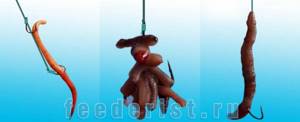
Method 2 - “Danish” . Take a thin brass tube (you can buy it at any fishing store). One end of it becomes sharp and a worm is pulled onto it. The tip (sting) of the hook is inserted from the opposite side of the tube, the fishing line is pulled, and the sand core from the tube through the hook is moved onto the fishing line so that the point (sting) comes out of the tail part.
How to properly tie a hook to a fishing line so that the bait does not slip is described here https://seatackles.blogspot.com.by/2011/11/blog-post_19.html
How to attach a worm when fishing?
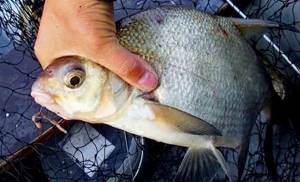
Half a worm
The most economical way is to plant a piece of worm. However, this is not a forced measure, as it might seem.
Using such a bait you can catch various and not only small non-predatory species of fish. This method is especially effective during winter ice fishing. Many professional fishermen note that fish bite more readily if the worm is more torn.
In open water, half a worm attracts fish better with its scent.
When the worm is whole
Another option is to insert the worm completely. This type of nozzle is suitable for any type. But there are some tricks and difficulties here.
Previously, the worm was placed with its head in such a way as to completely cover the metal part of the hook. However, now this method is considered effective only for catching large predatory fish, since its main features - endurance and mobility - are lost with such a bait.
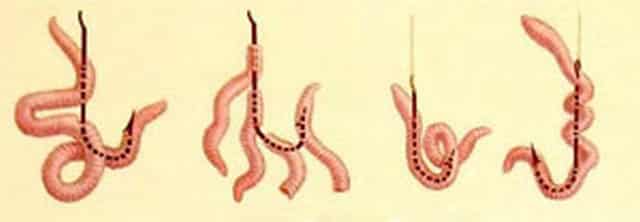
Small worms die quite quickly; to prevent this, they are pierced a little behind the head. However, this method also has its drawback: the worm is buried in the underwater soil by the current. Therefore, you have to periodically bring the bait to the surface.
You have to use various types of deceptive gear to make the worm bait rise from the bottom - for example, a piece of foam ball. Look - a floating nozzle.
Bunch of worms - bait for large fish
A bunch of worms is the best choice for targeting large fish. It is necessary to attach the worms by piercing them with a hook across, so they will remain alive and mobile for a longer time.
The hook is filled tightly and the tip is left free. Just as in the case of a whole worm, it is necessary to occasionally bring the bait to the surface.
Worm Sandwich Attachment
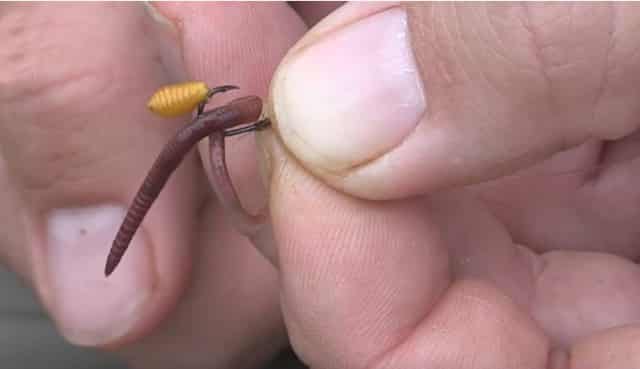
The worm is also actively used with other baits. For example, when catching non-predatory fish, it is often used together with corn and maggot.
More rare, but no less productive, is catching large fish with a worm along with a crawl or a piece of fish.
Useful and interesting: A tricky way to fish with a float where there is a lot of grass on the bottom - so as not to get confused.
5.What kind of fish can be caught with a worm in the Mediterranean Sea
It is a universal bait, suitable for many types of fish:
- cod;
- flounder;
- conger eel;
- laskir (saragus);
- mullet (the worm itself and its deposits);
- mullet;
- Denis;
- barkan;
- aras;
- smarida;
- mullet;
- sole.
Large fish species are caught on several sand baits. Part of the bait should be free.
6.Worm storage
- for storage, it is better to place it in a container with algae, after first washing the worm in sea water;
- a good place for long-term storage is a spacious wooden box or box with a lid and air holes, into which you need to pour sand mixed with coal and sprinkle seaweed on top;
- for short-term storage, you can wrap it in a newspaper package moistened with sea water;
- To store bait for no more than 5 days, a bundle of newspaper placed in the refrigerator is suitable. Periodically you need to sort through the worms, removing dead individuals. As soon as the package becomes damp, it should be replaced.
Crawling out
The largest of the red worms. One of the best baits for trophy bream, catfish, sterlet, chub and carp. Crawlings grow up to 30 cm long, with a thickness of up to 10 mm. The body has a dark brown tint. In the area of the head, this worm has a dark red thickening with a purple tint. The tail part is lighter than the head part. The end of the tail section is flattened.
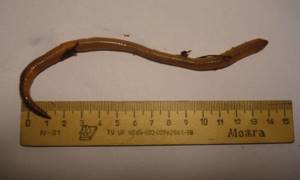
This type of worm lives in fields and near fields in rural areas and gardening communities. Sometimes small colonies of this worm are found near manure heaps and compacted leaves. You can find its habitat by the mounds of shiny earth, clearly visible on a flat surface. This worm is collected at night, when they partially emerge from the ground.
You need to collect the worm using a red lantern, moving very carefully, making as little noise as possible. At the slightest danger, this worm hides in its hole. It is almost impossible to get it out of there. There is a subspecies of this worm, which is smaller in size, and the color of the “dwarf” crawl is a little brighter. This crawl is a delicacy for almost any inhabitant of the rivers of the middle zone. It is difficult to store the creeper. In the home environment of a city apartment, long-term storage is impossible.
7.Helpful tips:
- The body of the sand bait is soft and when casting it slides off the hook.
- To thread an invertebrate onto a hook, it is most convenient to use a bait needle.
- Also use hooks with antennae and a long shank.
- For effective fishing, the bait is combined with other worms (for example, ringed worms), which are attached last to make the bait strong.
- It is not recommended to use curved hooks with a long shank, as it will be problematic to pull sandbars onto them.
- The use of this bait is most effective when fishing in the surf.
- You should attach it carefully, pulling it onto the hook, so that the juice does not leak out of the worm, which is a tempter for sea fish.
8. Interesting facts
The sandstone will never crawl out of the vessel (can). The peculiarity of these worms is that they gather in clubs.
For these invertebrates, the moment of high tide is very important, when water brings them not only food, but also oxygen, taking away carbon dioxide. The process of oxygen absorption occurs due to contraction of the muscles of the body so that it decreases in volume and this substance gets into the mink.
For some birds (wadied ones), sandworm is a favorite food. They wait for the moment the prey comes to the surface and capture the worm with their beak.
Peskozhil is capable of passing up to 16 tons of soil through its intestinal tract in 24 hours.
These worms are used in medicine by removing the antimicrobial component from their tissues.
Earthworm
This type of worm lives in moist soils in almost any populated area. In some places its concentration is greater, in others there are single specimens. It likes to stay either near water sources (pumps, small standing ponds) or in thick turf of grass, provided that the grass is often moistened. Often such a worm lives near streams that flow in the shade of trees. This worm is also often found under stones.

This worm is pale red in color. It grows up to 8 cm long, with a thickness of up to 6 mm. This worm is happily eaten by roach, chub, crucian carp, gudgeon, bream, and silver bream. Large fish, all other things being equal, bypasses it, possibly due to the poor mobility of this subspecies of the red worm.
It stays at shallow depths, but it is better to mine it with a shovel. When working with turf, a shovel is a must. In places where the vegetation is sparse, but there is a source of water nearby, you can again get it using a strong stick. It is enough to loosen the soil or turn over a stone lying near the water. You can store this worm in a jar by pouring a little soil into it and occasionally moistening the soil with water.
9.Useful links
https://fishers.spb.ru/publ/info/privady-i-prikormki-dlya-morskoy-rybalki - An article about bait, about what kind of fish can be caught with a sandworm;
https://kuz-fish.ru/articles/fishing-baits/sandstone.html - Useful article about methods of extracting sandstone;
https://www.samodel.3nx.ru/viewtopic.php?t=190 - An interesting article posted by an amateur fisherman on one of the fishing forums;
https://givotniymir.ru/peskozhil-cherv-obraz-zhizni-i-sreda-obitaniya-peskozhila/ - Detailed information about the worm, its structure, habitats, feeding method and other information that will help expand knowledge about this bait.
